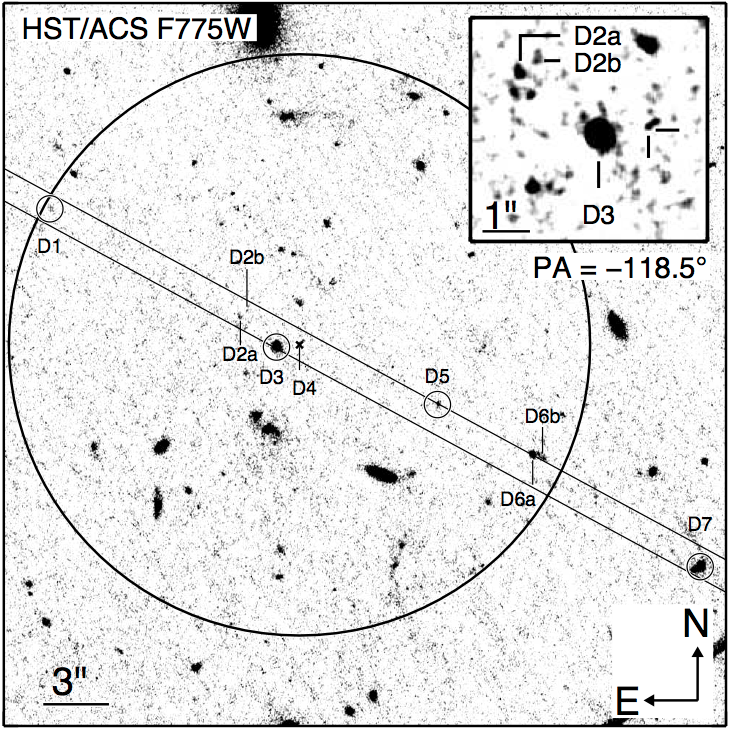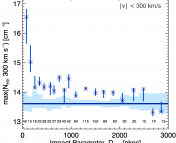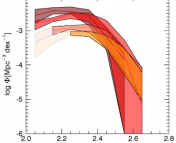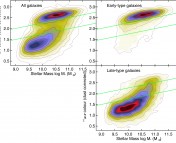Title: Galaxy counterparts of intervening high-z sub-DLAs/DLAs and MgII absorbers towards gamma-ray bursts
Authors: Steve Schulze et al.
First Author’s Institution: Centre for Astrophysics and Cosmology, University of Iceland
Hydrogen is the most abundant element in the periodic table, making up about three-quarters of all normal matter at the beginning of the Universe. Today, despite the billions of years since the Big Bang, the Universe is still composed of roughly three-quarters hydrogen and one-quarter helium. Along the way, however, not all of that originally neutral hydrogen has stayed the same: part of it cooled and clumped together to form molecules (otherwise known as H2), some of it went into the first stars (where it was turned into helium via nuclear fusion), and most of the rest was eventually ionized by those same stars and other sources of energetic photons. The location, state, and kinematics of hydrogen dictates when and where galaxies and stars form, and in lot of ways, many of the fundamental questions in astronomy are about understanding the “hydrogen cycle“, in the same way that atmospheric science on Earth relies on understanding the water cycle.
How we observe hydrogen depends critically on whether it is neutral, ionized, or molecular and how much of it there is. Neutral hydrogen is often detected via its characteristic absorption signature in quasar spectra (c.f., the Lyman-alpha forest), which occurs when hydrogen in the ground state absorbs a photon with 13.6 eV and jumps to the n=2 excited state, causing an absorption line at the rest-frame wavelength of 1216 Å . Even relatively small clumps of hydrogen produce absorption lines, and the redshift of each absorber can be calculated simply by comparing the observed wavelength of the absorption line with the rest-frame wavelength (1216 Å). For more curious readers, the method of using quasar spectra to study absorbing gas along the line-of-sight was discussed in two previous astrobites: one about metal absorbers and one about the gas near star-forming galaxies. When quasars are the background source, however, it is nearly impossible to find galaxies close to the line-of-sight because the quasar is so bright that it swamps the emission from anything nearby on the sky; since the strongest absorbers (called damped Lyman-alpha absorbers (DLAs), with column densities N > 2 x 1020 cm-2, or sub-DLAs, with column densities of 2 x 1020 > N > 1019 cm-2) are naturally closer to galaxies where the gas is denser, this limits our ability to find their galaxy counterparts. Some astronomers, including Steve Schulze and his collaborators, have instead tried to use spectra of gamma-ray bursts (GRBs) to locate absorbers, a method which has the advantage of being able to probe very near the line-of-sight after the gamma-ray burst has faded.

Figure 1: The field-of-view of GRB 070721B, showing the projected radius corresponding to 100 kpc at the redshift of the intervening absorber (z=3.094) and the position of the FORS1 slit. The cross-hair marks the location of the afterglow, and D4 is the source identified as the GRB host galaxy. Object D3 is the candidate galaxy counterpart to the intervening absorber, at a physical distance of 7.9 kpc from the GRB line-of-sight. The inset shows a close-up of the absorbing galaxy. (Figure from Schulze et al.)
Gamma-ray bursts are temporary sources of high-energy photons (hence their name!) and are typically associated with exploding or merging compact objects (often neutron stars). The initial burst is followed by emission at longer wavelengths (called the afterglow), which can be observed with more specialized ground-based instrumentation before it fades away. Like quasars, GRBs are very luminous and can be seen out to high redshifts (at least z > 8, when the Universe was less than a billion years old), so their spectra can be used to study absorbers over most of cosmic history. As mentioned above, once the afterglow has disappeared completely, additional imaging and spectroscopy in the field is used to characterize objects near the line-of-sight as well as the host galaxy.
In a paper posted to the arXiv a few days ago (and already accepted to Astronomy & Astrophysics), Steve Schulze and a group of international astronomers looked at four GRB fields with candidate strong absorbers and deep, multi-wavelength followup observations. Here, I only discuss one field (GRB 070721B, Figure 1), where their analysis resulted in the successful identification of a galaxy counterpart to the strong absorber in the spectrum of the GRB afterglow.
The afterglow spectrum of GRB 070721B showed a strong absorber at z=3.0939 with logN = 20.1. Four months after the GRB faded, a second spectrum was taken with VLT/FORS1 (Figure 2), covering the location of the afterglow and several additional sources. Analysis of the spectrum of object D3 revealed that it was a galaxy with strong Lyman-alpha absorption (logN = 20.7) at z = 3.096, with an impact parameter (i.e., projected distance) of 1″ from the location of the GRB host (object D4). Because of the proximity in redshift space and evidence of strong absorption by neutral hydrogen in the galaxy, Schulze et al. concluded that D3 was the galaxy responsible for the DLA absorption feature in the GRB afterglow spectrum. At the redshift of the absorber, 1″ corresponds to 7.9 kpc, which is well within the average impact parameter of DLA galaxies (13 kpc). Additional analysis of the galaxy’s spectrum showed that it is more luminous than DLA galaxies at low-redshift, but similar to star-forming galaxies at high-redshift. In fact, it appears to be similar in many ways to the population of Lyman-break galaxies, with a more extended halo of neutral hydrogen.
The Schulze et al. paper is the story of a new method leading to the the successful discovery of a DLA galaxy at high redshift, but is also a sobering reminder that it is still hard work to detect galaxies at high-redshift. The inability to identify galaxy counterparts to most of the strong absorption systems suggests they must be faint objects, requiring large telescopes and sensitive instruments to ensure detection. Still, using GRB afterglow spectra to identify strong absorption systems is likely to continue breakthroughs in understanding the characteristics of the HI-rich gas reservoirs, if we are able to devote the followup resources required to identify and study their galaxy counterparts.





